As Stetson students settle in for the fall semester, many face the challenge of food insecurity. Food insecurity is the experience of lacking food, in quality and/or quantity, to meet one’s basic needs. Stetson’s food pantry, the Hatters Helping Hatters Food Pantry, aims to combat this pressing issue. Affecting students across campus, it is shown in a National College Health Assessment survey that as of Fall 2023, 61.7% of Stetson students have or are currently experiencing food insecurity, which reduces graduation rates by 42%. This statistic highlights the multifaceted challenges students face concerning food access.
“Food insecurity is a lack of access to nutritional food, lack of access to food that meets your cultural or dietary restrictions, lack of access to food that is safe or within the expiration period,” August Maulfair–Food Equity Coordinator and AmeriCorps VISTA at Stetson University– said. “We hear from a lot of students that, ‘Oh, I had to skip dinner today because I was too busy studying,’ or ‘I had class.’ That’s food insecurity.”
Ali Burgess ’25 shares this common experience. “School is, in itself, sometimes kind of like a full-time job,” Burgess said. “In an effort to not burn myself out, I was working less at my outside-of-school job at the time. I lowered that to like 30 hours a week, and with balancing work and school life, things can feel a little bit tight.” Burgess holds the weight of many students who are financially self-supporting and pay for their tuition and cost of living out-of-pocket. Students like Burgess seek out the food pantry to feed themselves more nutritionally and consistently when time and money get tight.
Similar experiences inspired Nicole Currie to found the Hatter Pantry in 2013. Currie, Administrative Specialist II of Student Counseling Services, was working the front desk when she noticed this issue among students, leading her to spearhead the mission of bringing safe and nutritious foods to students in need, free of cost. Currie carried on this passion project for a decade, before passing the torch to Maulfair in July of 2024.
Students in need can access the food pantry at two campus locations. There is a pantry at the Cross-Cultural Center on Michigan Avenue that is open from 8:00 a.m. to midnight seven days a week. The second location is moving in mid-October from Griffith Hall to the Carlton Union Building, Rm. 278. The CUB location will be open during the CUB’s operating hours.
Both pantries are accessible by QR code, which anonymizes identifying information for the Food Equity Coordinator, such as the student’s name and ID number. The information is scrubbed to make utilizing the pantry a more comfortable and confidential experience for students. The QR code’s main purpose is to track the amount of users per month, so the pantry can report the data back to The Second Harvest Food Bank of Central Florida (SHFB-CFL), their primary donor.
“Pride and dignity are some of the biggest things that come up when people think about accessing food pantries at Stetson or out in the community,” Maulfair said. “We do as much as we can to maintain pride and dignity among our clients of the pantry. So one way that we do that is by ensuring confidentiality and anonymity,” Maulfair said.
The effort to meet the needs of students comes from the desire to see them thrive in their daily lives. Maulfair acknowledges the moments when food insecurity hinders the body and mind. “It can be so difficult to pay attention in class when you’re thinking about where your next meal is going to come from. Or, you’re thinking about how the only thing you had to eat this morning was a Hershey bar or a bag of chips,” Maulfair said. As Food Equity Coordinator, they hope to encourage students who are plagued by moments like this to seek assistance. “Anyone who is experiencing food insecurity: you’re not alone in that…We all want to see you eat, meet your body’s needs, and succeed as a student and as a human, and so you don’t need to suffer in silence. We’re all here for you and we all want you to be full,” Maulfair said.
Burgess echoes a similar sentiment to those struggling. “Any students who empathize with that feeling of food insecurity, I get it feels really isolating, which is why I think that the food pantry is so helpful,” they said. “It’s not an isolating, ‘calling-out’ kind of experience. It’s very welcoming.”
Maintaining the food pantry is a fulfilling yet arduous task. Even now that Stetson has a designated Food Equity Coordinator, the pantry has a low operating budget. It mainly relies on its partnership with SHFB-CFL, along with grants and donations to stay afloat.
The obstacles of maintaining a food pantry are minimalized with the help of students. There are multiple ways the Stetson community can contribute to the Hatter Pantry. One way a Hatter can contribute is by making monetary or food donations. It doesn’t have to be large. If many students make small contributions, it would make a huge difference. “Say you go to Publix for your weekly grocery trip, and there’s a buy-one-get-one-free can of beans,” Maulfair said. “If you want to donate us that free can of beans, that is feeding someone who would otherwise not have food.”
Another way Hatters can contribute is by volunteering. “No student is just a student, right? A lot of our students are involved in Greek life or athletics…or some other program,” Maulfair said. “With that comes a lot of resources of power. Maybe you need to do volunteer hours…There’s always work to be done with the pantry.”
“Alpha Tau Omega, they’ve been such a great partner for the food pantry,” Maulfair said. The fraternity has driven to Daytona Beach at 7 a.m. every Friday for the past year. The brothers enter deep freezers and lift hundreds of pounds of food for the Hatter Pantry. They then return to campus and sort the food. “They do the whole thing with a huge smile on their face, great energy, great attitudes,” Maulfair said. They hope that other Hatters will show similar excitement towards the food pantry.
Hatter contributions can help the food pantry to grow rather than survive. Moving forward, Maulfair would love to see an increase in food supply alongside storage growth, such as more shelving and freezers. They also hope to improve inclusivity for students with cultural or allergen needs, by allowing them designated food storage spaces. “I’d love to see a kosher food pantry, a halal food pantry and an allergen-safe food pantry because the food pantry should exist to serve every single Stetson student,” Maulfair said. The daily goal of the pantry is for students to not only visit the food pantry but be excited about the items they find. Growth can become more than a desire with the help of volunteers and donors.
If you are interested in volunteering individually or through an organization, email August Maulfair at [email protected]. Students can leave food and toiletry donations in the box outside of CUB Rm. 267. They can also bring donations to either pantry location. If you cannot travel to these locations, email Maulfair to coordinate a time to have your donations picked up.
As Food Equity Coordinator, Maulfair also performs work related to SNAP enrollment and eligibility screening. To learn more about the Supplemental Nutrition Assistance Program and if you might be eligible, email [email protected].



